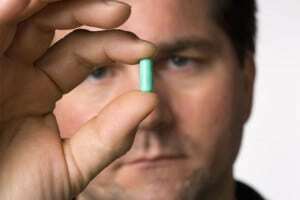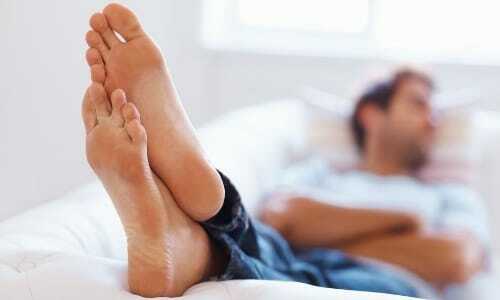Bedwetting in men is pathological in nature. More than 7% of the male population of the world suffer from incontinence under the age of 60 years. The causes of the disease are varied.

Causes of the disease
There are a number of pathological processes in the body of men that affect urinary incontinence. The presence of the following factors leads to the appearance of the disease:
- Chronic prostatitis in men;
- Neurological disorders of the patient's psyche;
- Disturbance of the smooth muscle of the bladder;
- Chronic diseases of the genitourinary system;
- Congenital abnormalities of the bladder.
Prostate adenoma is a common cause of urinary retention in men. Inflammatory process in the prostate gland leads to tissue proliferation. Increased iron compresses the urinary tract. On the transmitted area of the bladder, fluid accumulation is formed, since urine can not rise to the level of the urinary tract. The man has frequent urge to urinate.
Neurology affects uncontrolled urination at night. Dysfunction of the area of the brain responsible for urination leads to the impossibility of controlling urinary excretion. At night, the process of urine release is more active, since the brain is at rest.
 Men who have recovered from a number of sexually transmitted diseases are prone to urinary retention. Viruses lead to inflammatory processes in the bladder. The smooth muscle of the bladder remains inflamed after treatment and is unable to contract properly. At night, the patient can not control the urinary process, since the muscles are completely relaxed.
Men who have recovered from a number of sexually transmitted diseases are prone to urinary retention. Viruses lead to inflammatory processes in the bladder. The smooth muscle of the bladder remains inflamed after treatment and is unable to contract properly. At night, the patient can not control the urinary process, since the muscles are completely relaxed.
Chronic diseases of the kidney and genitourinary system affect bedwetting. Incorrect or incomplete treatment leads to inflammatory processes in the bladder. Kidney disease affects the composition of urine. The presence of inflammation in the kidneys leads to an increase in protein in the urine. Urine changes its density. The urge to urinate increases.
There are a number of congenital bladder pathologies that affect incontinence. During an involuntary coughing, sneezing or sneezing, urine may be ejected due to improper placement of the bladder. If the neck of the bladder is displaced, the smooth muscle of the bladder does not shrink completely. Alzheimer's disease leads to the independent work of the bladder. The reflux of emptying the bladder becomes "childish."As the bubble is filled with liquid, involuntary urine withdrawal occurs. Man can not regulate this pathology independently.
Methods of treatment of the disease
For the correct selection of treatment a man needs to undergo a series of studies and examination with a urologist. The patient must pass a detailed analysis of urine for the presence of viruses and inflammations, undergo an external examination with a urologist and get a therapist's conclusion. After establishing the reasons for the emergence of urinary incontinence at night, one of the following treatment methods is selected:
- Treatment with medication;
- Surgical intervention;
- Ultrasound and microwave therapy;
- Physical activity of the genitourinary system.
Medical treatment of incontinence is the longest process of improving the genitourinary system with a long-term remission of the disease.
 The pharmaceutical industry has developed a number of drugs that affect the contraction of the smooth muscles of the bladder. For quality treatment, men are prescribed antibiotics and non-steroidal anti-inflammatory drugs. Prolonged and schematic treatment with the help of medications allows you to get rid of the cause of wet urine and uncontrolled emptying of the bladder.
The pharmaceutical industry has developed a number of drugs that affect the contraction of the smooth muscles of the bladder. For quality treatment, men are prescribed antibiotics and non-steroidal anti-inflammatory drugs. Prolonged and schematic treatment with the help of medications allows you to get rid of the cause of wet urine and uncontrolled emptying of the bladder.
A number of surgical interventions in the body have been developed that affect the emptying of the bladder. Surgeons often resort to two types of surgery: an incision of the neck of the bladder and balloon plastic.
An incision on the neck allows you to get rid of stenosis of the bladder and normalizes the outflow of fluid. When stenosis often occur, the neck of the bladder arises and the narrowing of the opening in the ureter. Both cases are amenable to surgical correction. After the operation, the man is restored within a week.
Balloon plastic of the urethra is the least traumatic operation. The patient is able to walk independently 5-6 hours after surgery. The discharge is carried out on 3-5 days.
To enlarge the urethra, a small balloon is inserted into the ureter. A special saline solution is poured into the balloon through a special opening. Under the influence of the balloon the urethra expands. The urinary catheter is placed on the patient for three days. After removal of the catheter, discomfort in the area of the ureters may occur, which will disappear on the second day. Balloon plastic is used for urinary maintenance in men with prostatitis. In this case, the balloon is inserted into the rectum and placed in the prostate gland. When the canister is filled with liquid, the pressure on the gland increases, and it moves away from the ureter. The surgical operation will take 30 minutes of time and is performed on an outpatient basis.
 Ultrasound and microwave therapy are similar in effect. In both cases, they affect the proliferation of prostate tissue. Microwaves remove the tissue with the heat that they produce. Ultrasound destroys the pathogenic zone by means of waves. Softened tissues are removed from the body with an aspirator. Ultrasonic incontinence therapy is little studied and is rarely used, the most popular microwave treatment.
Ultrasound and microwave therapy are similar in effect. In both cases, they affect the proliferation of prostate tissue. Microwaves remove the tissue with the heat that they produce. Ultrasound destroys the pathogenic zone by means of waves. Softened tissues are removed from the body with an aspirator. Ultrasonic incontinence therapy is little studied and is rarely used, the most popular microwave treatment.
Risks of surgical intervention
When conducting an operative intervention in the body of a man, there are risks of side effects. The following pathologies may occur:
- Ejaculation in men;
- Impotence;
- Erection loss.
In case of incorrect surgical intervention, a man can disrupt the process of excretion of the ejaculate. During an orgasm, the seminal fluid is not discharged outside, but into the bladder. This pathology requires an additional operation.
In 5% of operated patients, impotence may occur. Complete loss of erectile function leads to further infertility in men.
Erection loss occurs in 3% of men and does not need additional treatment. The very process of sexual intercourse brings the patient the same sensations, the patient loses the ability to experience orgasm. This side effect disappears within three months after surgery.
Adverse events do not occur in men who have a normal functioning of the reproductive system.
The appearance of abnormalities in the genital area indicates that the patient has a hidden venereal infection and requires additional medication.
A man suffering from urinary incontinence does not get enough sleep, becomes irritable and restless. Many patients are embarrassed to report a delicate problem. If there is a frequent urge to urinate, a man should immediately consult a urologist and undergo a full course of treatment.



